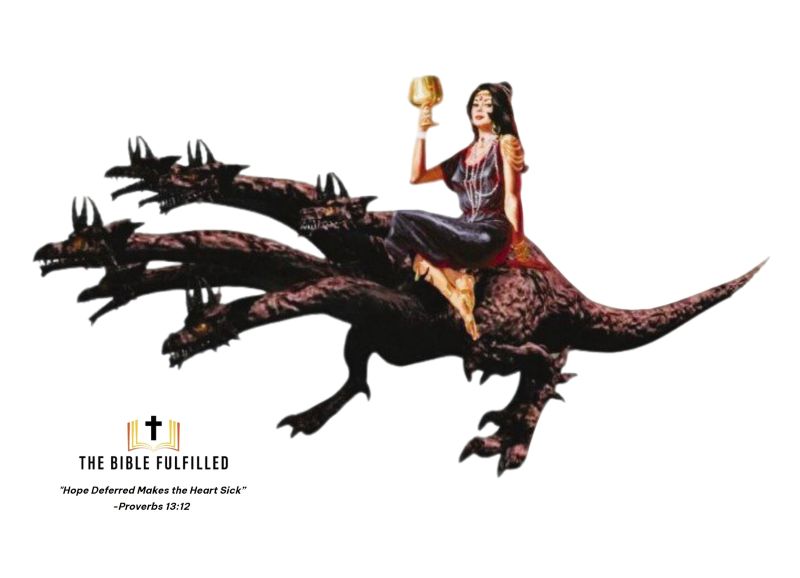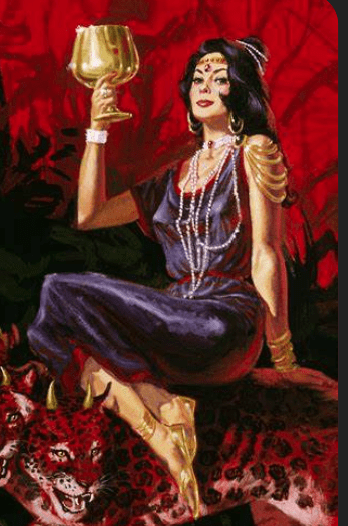The Harlot, Mystery Babylon, and the Seven-Headed Beast (of Revelation 17)

“1 Come, I [the angel of Revelation] will show you [John] the judgment of the great harlot who sits on many waters, 2 with whom the kings of the earth committed fornication, and the inhabitants of the earth were made drunk with the wine of her fornication. 3 So he carried me away in the Spirit into the wilderness. And I saw a woman sitting on a scarlet beast which was full of names of blasphemy, having seven heads and ten horns. 4 The woman was arrayed in purple and scarlet, and adorned with gold and precious stones and pearls, having in her hand a golden cup full of abominations and the filthiness of her fornication. 5 And on her forehead a name was written: ‘MYSTERY, BABYLON THE GREAT, THE MOTHER OF HARLOTS AND OF THE ABOMINATIONS OF THE EARTH.’ 6 I saw the woman, drunk with the blood of the saints and with the blood of the martyrs of Jesus. And when I saw her, I marveled with great amazement†(Rev. 17:1–6).
The Harlot
Revelation describes a harlot sitting upon a seven-headed beast (Revelation 17:1–3). The harlot is a blatant reference to the Jewish religious leadership in the first century. Israel was supposed to be married to Yahweh—and only Yahweh. Israel was to have no other gods. She was supposed to be faithful to God. Yet in the first century, Israel was more loyal to Rome than God. “We have no king but Caesar,†the chief priests said (John 19:15). Israel had become like a harlot fornicating with other gods (political/religious powers).
Israel had been called a harlot many times throughout her checkered history, whenever she went after other gods (see Hos. 9:1, Jer. 2:20 24, 3:2–3; Ez. 23:14–20; Isa. 1:21; 57:7–9). And this is also how Jesus described the Israel of his day. Jesus called her an “adulterous generation†(Matt. 12:39, 16:4)—a harlot, if you will—because she was fornicating with other gods, namely, Rome.
Here’s another reason we know the harlot refers to first-century Israel. Compare Revelation’s description of the harlot persecuting the saints to Jesus’s description of the Jewish leadership of his day. Notice the references to persecution and blood.
In Revelation, the harlot is described as “drunk with the blood of the saints and with the blood of the martyrs of Jesus.†(Rev. 17:6).
Now here’s how Jesus described the Jewish leadership of his day: “Serpents, brood of vipers!…I send you prophets, wise men, and scribes: some of them you will kill and crucify, and some of them you will scourge in your synagogues and persecute from city to city, that on you may come all the righteous blood shed on the earth, from the blood of righteous Abel to the blood of Zechariah, son of Berechiah, whom you murdered between the temple and the altar. Assuredly, I say to you, all these things will come upon this generation†(Matt. 23:33–36).
Jesus and John (Revelation) were clearly describing the same harlot, the Jewish establishment in the first century, who was guilty of shedding the blood of the prophets and saints.
And when did Jesus and John say this harlot would be judged? Jesus said in AD 30 that she would be judged within a generation (Matt. 23:36). By around AD 65, John said this great judgment (Rev. 11:18; 16:15–20) was “at hand†(Rev. 1:1–3, 22:10–12). Jesus and John were clearly describing the same judgment of the Jewish establishment, aka the harlot, which happened in AD 70!
Notice, also, John’s (Revelation’s) description of the harlot’s forehead:
“MYSTERY, BABYLON THE GREAT, THE MOTHER OF HARLOTS AND OF THE ABOMINATIONS OF THE EARTH†(Rev. 17:5)

This is the exact opposite of what righteous priests wore on their foreheads: “holiness to the lord†(Ex. 28:36). By using this imagery (of Exodus), John was implying that the religious leaders of his day had become the exact opposite of what they were supposed to be.
The harlot is also described as “arrayed in purple and scarlet, and adorned with gold and precious stones and pearls, having in her hand a golden cup full of abominations and the filthiness of her fornication†(Rev. 17:4). Now compare this to the attire of the righteous priests described in Exodus: “They shall take the gold, blue, purple, and scarlet thread, and the fine linen and they shall make the ephod of gold, blue, purple, and scarlet thread, and fine woven linen, artistically worked… Then you shall take two onyx stones and engrave on them the names of the sons of Israel…†(Ex. 28:5–6, 9–10). Same precious stones. Same purple and scarlet. John’s point was that although the religious leaders of his day looked like righteous priests, they were in fact full of abominations.
Jesus, too, had made a similar comment during his ministry: “Beware of the scribes, who desire to go around in long robes, love greetings in the marketplaces, the best seats in the synagogues, and the best places at feasts [yet] who devour widows’ houses, and for a pretense make long prayers†(Mark 12:38–39, italics mine).
The harlot of Revelation was clearly the Jewish establishment in the first century!
Mystery Babylon
What about the identity of “mystery, Babylon the great, the mother of harlots and of the abominations of the earth†(Rev. 17:5)? Since we know “the harlot†refers to the Jewish establishment in John’s day, it’s pretty easy to figure out who mystery Babylon is. After all, she is “the mother of harlots.†Mystery Babylon obviously refers to Jerusalem. This is where the religious leadership resided because this is where the temple was located.
That “Mystery Babylon†refers to Jerusalem is confirmed elsewhere in Revelation too. John says Mystery Babylon is “the great city…where the Lord was slain†(Rev. 11:8). Jesus was crucified in Jerusalem, which means Mystery Babylon refers to Jerusalem.
The reason why John (Revelation) called Jerusalem “Babylon†is that the Jerusalem of his day had become as wicked as the real Babylon of the 5th century BC. And Jerusalem (aka Mystery Babylon) would soon be judged in the same way as the real Babylon was.
And she was…just a few years later in AD 70.
The Seven-Headed Beast
What about the identity of the seven-headed beast that the harlot was “riding†(fornicating with)? This is an obvious reference to the Rome. John said, “The seven heads are seven mountains on which the woman [harlot] sits†(Rev. 17:9–11). The “seven mountains†are an obvious reference to the famed “seven hills of Rome,†which John would have been very familiar with. The seven hills of Rome are the group of hills on which the ancient city was built. The seven hills of Rome are the Caelian, Palatine, Aventine, Esquiline, Viminal, Quirinal, and Capitoline.
The Timing Indicators Confirm All This
The above scriptural analysis shows that the Harlot refers to the Jewish establishment in the first century; and Mystery Babylon refers to first-century Jerusalem; and the Seven-Headed Beast refers to first-century Rome. Moreover, the timing indicators further confirm this. In fact, all the events of Revelation had to have come to pass soon after the book was written. The book’s opening words are:

“The Revelation of Jesus Christ, which God gave Him to show His servants—things which must shortly take place. And He sent and signified it by His angel to His servant John, who bore witness to the word of God, and to the testimony of Jesus Christ, to all things that he saw. Blessed is he who reads and those who hear the words of this prophecy, and keep those things which are written in it; for the time is near†(Rev. 1:1–3)
And to drive this point home even further—so that nobody could possibly miss it—John repeated this statement at the end of the book:
“Then he [the angel] said to me [John], ‘These words are faithful and true.’ And the Lord God of the holy prophets sent His angel to show His servants the things which must shortly take place. ‘Behold, I [Jesus] am coming quickly! Blessed is he who keeps the words of the prophecy of this book…Do not seal the words of the prophecy of this book, for the time is at hand’†(Rev. 22:6–10).
These time statements are the key to understanding Revelation.
For a detailed discussion of the topics discussed in this article, get my book The End Is Here: How the New Testament’s Prophecies Were Fulfilled.
By Alex Polyak, Director of The Bible Fulfilled, 10/4/24
